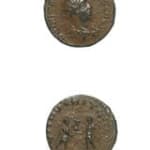Silver Antoninianus of Saloninus Struck While Caesar, 258 CE - 260 CE
Silver
C.4748
Obverse: P COR SAL VALERIANVS CAES; Radiate and Draped Bust of the Emperor Facing Right Reverse: DII NVTRITORES; Jupiter, Standing on the Right, Presenting Victory to Saloninus, Standing on the...
Obverse: P COR SAL VALERIANVS CAES; Radiate and Draped Bust of the Emperor Facing Right
Reverse: DII NVTRITORES; Jupiter, Standing on the Right, Presenting Victory to Saloninus, Standing on the Lef
Publius Licinius Cornelius Saloninus Valerianus was the younger son of Emperor Gallienus. Upon the death of his older brother Valerian II in 258 A.D., he was the rank of Caesar. Soon after, he was sent to the German frontier. In 260 A.D., he got into an argument with the commander of the Rhine armies, Postumus, over the division of barbarian booty that would have severe repercussions in the future. When Valerian I was capture by the Persian King Shapur, Postumus seized the opportunity to have himself proclaimed Augustus by his troops. Meanwhile, Saloninus had retreated to his headquarters in Cologne. Postumus laid siege to the city and shortly after his troops declared Saloninus Augustus, they surrendered. Saloninus was promptly executed.
How many hands have touched a coin in your pocket or purse? What eras and lands have the coin traversed on its journey into our possession? As we reach into our pockets to pull out some change, we rarely hesitate to think of who might have touched the coin before us, or where the coin will venture to after it leaves our hands. More than money, coins are a symbol of the state that struck them, of a specific time and location, whether contemporary currencies or artifacts of a long forgotten empire. This stunning hand-struck coin reveals an expertise of craftsmanship and intricate sculptural detail that is often lacking in contemporary machine-made currencies. This ancient coin is a memorial to an emperor passed from the hands of civilization to civilization, from generation to generation that still appears as vibrant today as the day it was struck.
Reverse: DII NVTRITORES; Jupiter, Standing on the Right, Presenting Victory to Saloninus, Standing on the Lef
Publius Licinius Cornelius Saloninus Valerianus was the younger son of Emperor Gallienus. Upon the death of his older brother Valerian II in 258 A.D., he was the rank of Caesar. Soon after, he was sent to the German frontier. In 260 A.D., he got into an argument with the commander of the Rhine armies, Postumus, over the division of barbarian booty that would have severe repercussions in the future. When Valerian I was capture by the Persian King Shapur, Postumus seized the opportunity to have himself proclaimed Augustus by his troops. Meanwhile, Saloninus had retreated to his headquarters in Cologne. Postumus laid siege to the city and shortly after his troops declared Saloninus Augustus, they surrendered. Saloninus was promptly executed.
How many hands have touched a coin in your pocket or purse? What eras and lands have the coin traversed on its journey into our possession? As we reach into our pockets to pull out some change, we rarely hesitate to think of who might have touched the coin before us, or where the coin will venture to after it leaves our hands. More than money, coins are a symbol of the state that struck them, of a specific time and location, whether contemporary currencies or artifacts of a long forgotten empire. This stunning hand-struck coin reveals an expertise of craftsmanship and intricate sculptural detail that is often lacking in contemporary machine-made currencies. This ancient coin is a memorial to an emperor passed from the hands of civilization to civilization, from generation to generation that still appears as vibrant today as the day it was struck.



